Yves GARY Hits: 3969
Category: 1903 : CHALLENGE N°12
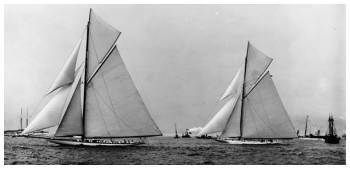 Reliance Rounds Outer Mark Two Miles Ahead of Shamrock Ill
Reliance Rounds Outer Mark Two Miles Ahead of Shamrock Ill Aug. 21, 1903 - To Reliance and Shamrock Ill., to the owners of the two great yachts, and to the many thousands who journeyed down the bay to see them race, yesterday was a day of disappointment. The yachtsmen were disappointed because there was not enough wind to drive the yachts around ...
Aug. 21, 1903 - To Reliance and Shamrock Ill., to the owners of the two great yachts, and to the many thousands who journeyed down the bay to see them race, yesterday was a day of disappointment. The yachtsmen were disappointed because there was not enough wind to drive the yachts around ...
... the thirty-mile course within the five-and-one-half-hour limit; the spectators were disheartened because there was more than enough rain thoroughly to drench them.
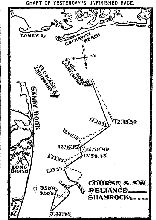 THE RACE IN DETAIL
THE RACE IN DETAILIt was not a race, but it was race enough to show pretty conclusively the relative standing of the yachts under the prevailing conditions. The prevailing conditions were light weather, so light that the Reliance took more than four and a half hours to cover the fifteen miles between the lightship and the outer mark, which means that at times there was not more wind than barely enough to make steerage way. Yet the wind did not fall so light until at least ten knots or the fifteen had been covered and the defender had fairly won a commanding lead and brought the mark in plain sight.
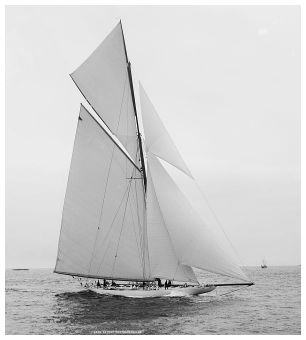 The wind was light at the start, less than four knots, but during two squalls that succeeded each other after a short interval it rose somewhat. Then it gradually died away again almost to the zero point. For at least three hours, however, whether high or low, it held fairly steady at south-southwest, and the yachts fared equally. So the result while the wind held was a fair enough test.
The wind was light at the start, less than four knots, but during two squalls that succeeded each other after a short interval it rose somewhat. Then it gradually died away again almost to the zero point. For at least three hours, however, whether high or low, it held fairly steady at south-southwest, and the yachts fared equally. So the result while the wind held was a fair enough test.
At the preparatory signal at 10:45, the Reliance, standing eastward with boom on the port hand and lifted sheets, was crossing the bows of the committee boat Navigator anchored north-northeast of the Sandy Hook lightship. The lightship, it must be borne in mind, was at the windward end of the line. Shamrock was about half a cable's length, say 120 yards, to leeward, also standing to the eastward. She passed astern of the Navigator, and subsequently hauled up to windward of Reliance‘s wake.
The course had been previously given as south-southwest, and the tug John S. Scully had been sent off to lay it. The guide boat Coastwise had also been started after her to take position in advance of the racers. It already has been said that the wind was light, yet there was enough to give the yachts life. The sea was smooth, except for a rather heavy ground swell which became heavier as the yachts advanced seaward. The yachts were equally clothed, except in one respect. Both had their largest club topsails above the ordinary working sails, but the Shamrock flaunted a considerably larger jib topsail than the Reliance.
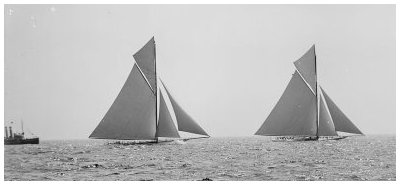 The Reliance went on the port tack a few seconds before the warning signal at 10:55, to cross tacks with the Shamrock, and at the smoke of the gun was crossing the latter‘s bows. The Shamrock went to port at gun fire and both then stood westward for the line, which was perhaps three-quarters of a mile away. The Reliance had the better pace at the moment and drew visibly ahead. But the wily Scotch skipper was holding his vessel in leash. That fact became plain later when he let her go free.
The Reliance went on the port tack a few seconds before the warning signal at 10:55, to cross tacks with the Shamrock, and at the smoke of the gun was crossing the latter‘s bows. The Shamrock went to port at gun fire and both then stood westward for the line, which was perhaps three-quarters of a mile away. The Reliance had the better pace at the moment and drew visibly ahead. But the wily Scotch skipper was holding his vessel in leash. That fact became plain later when he let her go free.
The starting signal was given at 11 o‘clock, before either yacht had reached the line. The Reliance was still leading by several lengths, but she was southward of the lightship and had to bear away to the northward to round it. She wore ship and stood to cross close to the windward end of the line. There had been no jockeying, but Barr had shown good judgment in taking a position which rendered it impossible for his adversary to get to windward. Wringe, however, had a plan of his own, and he carried it out neatly. 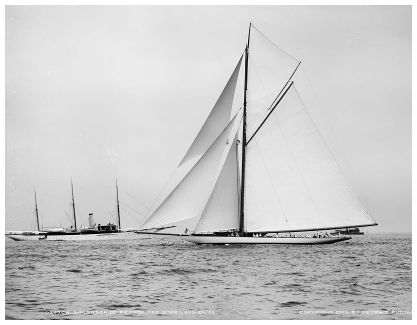 He had so timed his pace as to reach the line before the Reliance, and, once above it, tacked quickly and went over in the lead and, though in the leeward place, with his wind perfectly free. He had secured a lead of 33 seconds. The official times of the start: Shamrock III, 11:01:14; Reliance, 11:01:41.
He had so timed his pace as to reach the line before the Reliance, and, once above it, tacked quickly and went over in the lead and, though in the leeward place, with his wind perfectly free. He had secured a lead of 33 seconds. The official times of the start: Shamrock III, 11:01:14; Reliance, 11:01:41.
They went off on the starboard tack, heading about south by east half east for the open ocean. Shamrock showed immediately much more life than in the preliminary maneuvering, and therefore seemed at first to be dropping the Reliance. But the Reliance was not lagging. It was instantly apparent that she was looking closer to the wind. The yachts were going almost head into the ground swell, and they churned up the foam at each dive. There was little difference between them in this respect, but the Reliance rolled the less of the two. For at least a quarter of an hour it was difficult for the unpracticed eye to determine which was gaining the advantage. Surely, if slowly however, the Reliance was drawing away to windward and thus taking the lead, though the Shamrock seemed to be ahead. Eventually it was plain to everyone that the yachts were abreast and the Reliance fully 100 yards to windward. And that was their relative position before they had been sailing half an hour.
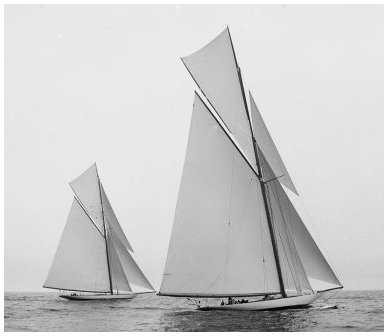 Capt. Wringe did not relish the situation. He had given his boat a full to drive her ahead and keep clear of his adversary. Yet here was that adversary in less than half an hour on his weather beam. He had set a larger jibtopsail to make his boat foot faster in the light air prevailing, but the Reliance, with a smaller jib topsail, was steadily outfooting him. At 11:25:30 he doused his jib topsail, and three minutes later broke out a smaller one.
Capt. Wringe did not relish the situation. He had given his boat a full to drive her ahead and keep clear of his adversary. Yet here was that adversary in less than half an hour on his weather beam. He had set a larger jibtopsail to make his boat foot faster in the light air prevailing, but the Reliance, with a smaller jib topsail, was steadily outfooting him. At 11:25:30 he doused his jib topsail, and three minutes later broke out a smaller one.
The yachts held on the starboard tack for more than an hour until the guide boat had dwindled to a mere speck in the southwest. Shamrocks skipper evidently did not want to go about under the Reliance’s lee and the skipper of the Reliance had no idea of breaking tacks with his adversary. Finally Wringe threw the Shamrock to port at 12:18:50. The Reliance followed to port at 12:20:35, and her position was then well up on the weather bow of the Shamrock. And now a thing happened that gave the inexperienced observers much concern for a while. The Shamrock steadily closed up the gap between herself and Reliance, and in less than ten minutes reached through her lee.
The friends of the defender were concerned, and the admirers of the challenger found their drooping spirits wonderfully revived. But there was no cause for depression on the one hand or exhilaration on the other. What happened was simple enough and not at all surprising when understood. 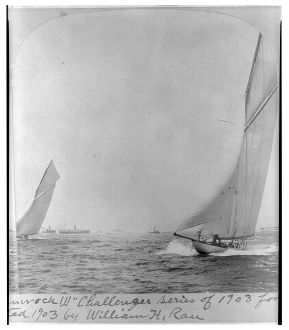 Wringe, finding that he could not keep the Shamrock in the wind and make her foot with the Reliance eased her off and gave her a good full in the vain hope that he could get to the front by that means. How vain the hope was shown when the yachts made the next tack. The Reliance had increased her lead so plainly that, though the Shamrock again reached through her lee nobody was moved to make a remark on the subject.
Wringe, finding that he could not keep the Shamrock in the wind and make her foot with the Reliance eased her off and gave her a good full in the vain hope that he could get to the front by that means. How vain the hope was shown when the yachts made the next tack. The Reliance had increased her lead so plainly that, though the Shamrock again reached through her lee nobody was moved to make a remark on the subject.
The port tack was a comparatively short one. The Shamrock returned to starboard at 12:45:15 and the Reliance at 12:46:15. This tack was held for less than a quarter of an hour. Shamrock again took the initiative and went to port at 12:58:40, and the Reliance five second later tacked to port nearly three-quarters of a mile in front of the tip of her bowsprit. The race was over, so far as any doubt of the result was concerned; the only question unsettled was as to how many minutes lead the Reliance would have at the outer mark. Guesses were freely made at from five to ten minutes.
The mark boat was now in plain sight, and it seemed probable that the Reliance would fetch it on the next tack, and the wag in which she began to draw away from the Shamrock appeared to justify the opinions of those enthusiasts who had ventured to give her ten minutes’ lead for the windward leg. At 1:23:45, Shamrock went to starboard and, though more than a mile astern, seemed to be in position to fetch the mark. Reliance went on the starboard tack at 1:23:55 to windward as well as ahead.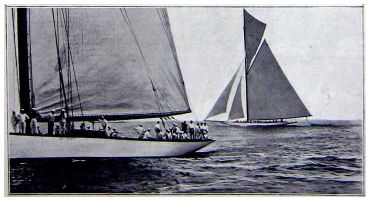
Up to this time the wind, though gradually falling, had held fairly steady, and there had been a gratifying absence of flukes. Reliance was heading straight for the mark, and it was a reasonable estimate that she would turn it in half an hour. But just here the wind fell flat. Shamrock was the first to fall off her course. She had previously taken in her little jibtopsail and set a larger one. Reliance about the same time took in her working staysail and replaced it with a balloon. At 2:06 she headed off to the southeast, and four minutes later she set a balloon jib topsail, as if she were bound for the Azores For some inscrutable reason Barr tried the same sail on the Reliance, and was presently also heading for the other side of the Atlantic. Thus the excursionists were edified by the singular spectacle of two yachts trying to beat to windward with a single head sail, and that a balloon jibtopsail.
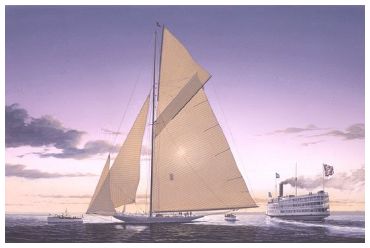 The wind now fell very light, and though the boats kept steerage way they made little progress toward the mark. When Reliance tacked to port at 2:53 o'clock she sailed back along parallel with the line she had held on the starboard tack. She did little better when she returned to the starboard tack at 3:06. Shamrock all the while held to the starboard tack, and about 3:15 she caught a streak of wind from the northwest that enabled her to head straight for the mark. Reliance did not catch it until several minutes later, but when she did she came for the mark with a big bone in her teeth. She rounded the mark amid a deafening salute of steam whistles at 3:37:20.
The wind now fell very light, and though the boats kept steerage way they made little progress toward the mark. When Reliance tacked to port at 2:53 o'clock she sailed back along parallel with the line she had held on the starboard tack. She did little better when she returned to the starboard tack at 3:06. Shamrock all the while held to the starboard tack, and about 3:15 she caught a streak of wind from the northwest that enabled her to head straight for the mark. Reliance did not catch it until several minutes later, but when she did she came for the mark with a big bone in her teeth. She rounded the mark amid a deafening salute of steam whistles at 3:37:20.
Shamrock was then over two miles astern, but as the time limit of five and one-half hours for the race was less than an hour away she was secure against losing for the day. Reliance, on the home stretch, met her going out at 3:44:47. As soon as the Reliance passed the Shamrock put about and followed homeward. The former signaled for a tow at 3:50 and the latter, at the same time dropped her club-topsail. The struggle was over for the day.
